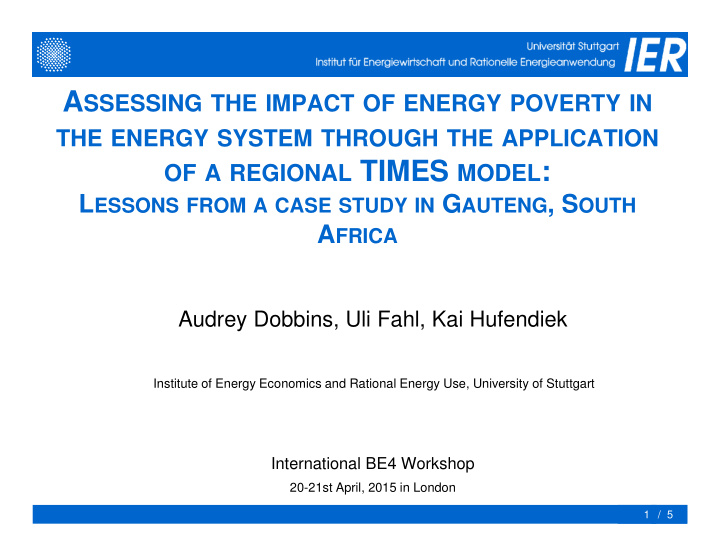



A SSESSING THE IMPACT OF ENERGY POVERTY IN THE ENERGY SYSTEM THROUGH THE APPLICATION OF A REGIONAL TIMES MODEL : L ESSONS FROM A CASE STUDY IN G AUTENG , S OUTH A FRICA Audrey Dobbins, Uli Fahl, Kai Hufendiek Institute of Energy Economics and Rational Energy Use, University of Stuttgart International BE4 Workshop 20-21st April, 2015 in London 1 / 5
Background: Gauteng Province, South Africa Source: http://www.southafrica.info www.enerkey.info Gauteng Population 10.4 mil Households 3.2 mil Urbanisation 98% Electrification 84% Audrey Dobbins Modelling energy poverty 20-21 April 2015
Residential energy consumption Audrey Dobbins Modelling energy poverty 20-21 April 2015 3
Residential sector – Assumptions and drivers of energy demand Income group Poor-Income Low-Income Mid-Income High-Income Annual R9,601 – R76,801 – R1 – R9,600 R307,201 + Income R76,800 R307,200 Number of HH 705,224 1,430,872 651,292 388,191 % HHs 22.2% 45.1% 20.5% 12.2% % total Energy use 4.2% 22.3% 32.2% 41.3% GJ/HH/a 12.3 13.9 34.7 51.5 Dominant Electricity Electricity Electricity Electricity Energy (60%), (71.5%), (86.4%), (89.1%), carriers paraffin paraffin LPG LPG cooking, water cooking, water water heating, water heating, Energy service heating, heating, space heating, space heating, priorities appliances appliances appliances lighting Future demand dependent on population and income Audrey Dobbins Modelling energy poverty 20-21 April 2015 4
Living standards characteristics POLICIES HOUSING TECHNOLOGIES / FUELS DEMOGRAPHICS TYPE / end-uses building COOKING materials Renewable Electricity income Gas stove energy GDP Free standing Gas elec stove Energy population efficiency Wood Semi- SPACE HEAT detached households Oil Carbon Elec emissions Flats Solar ... GAS Access to Informal … WATER HEATING energy ... Elec geyser Energy SWH subsidies ... ... Living Household size Energy Building type & Typical appliances space size (ppl/HH) sources efficiency and efficiencies + + + + (m2) Typical consumption profiles for end-use for each of the different housing types, income groups, living Audrey Dobbins Modelling energy poverty 20-21 April 2015 standards (hot water, space heating, cooking profiles)
Residential sector energy system Energy supply Energy demand 1. Four income 2. Income specific building 4. Energy carriers 3. Income specific groups types, income specific technologies consumption profiles Electricity High income Gas/LPG Paraffin Medium Coal income Wood Low income Solar For example, income specific SWH, elec. Biomass, Poor income geyser, other other technologies Audrey Dobbins Modelling energy poverty 20-21 April 2015 6
Other factors influencing behaviour Barriers Impact Policies impacting fuel choice (e.g., subsidies, VAT removal) Access Infrastructure (electrification, gas) Perception / cultural tradition (e.g. smoke) Acceptance Perception (e.g., SWHs) perception (e.g., gas is dangerous) High upfront costs of efficient technologies Lifestyle choices and purchasing priorities Affordability Suppressed demand and disposable income Modelled with a mix of user constraints and discount rates Audrey Dobbins Modelling energy poverty 20-21 April 2015 7
The reference scenario: Residential results Electricity Candles Coal LPG NG Paraffin Solar Wood 90 Final residential energy consumption by income 80 70 60 group [PJ] 50 40 30 20 10 0 2007 2010 2020 2030 2040 2007 2010 2020 2030 2040 2007 2010 2020 2030 2040 2007 2010 2020 2030 2040 high medium low poor � Different solutions for different income groups � Each income group has a different motivation for engaging – higher income groups can afford to meet GHG targets, become more efficient, increase comfort and act as forerunners, while lower income households are trying to afford a better living standard and want to save money � The best solutions are still not necessarily what people do. (e.g. SWH). Audrey Dobbins Modelling energy poverty 20-21 April 2015 8
Income specific transport characteristics � Analysis of availability of passenger cars by income class � Assessment of mode of transport by employment level � Travel demand characteristics www.enerkey.info Audrey Dobbins Modelling energy poverty 20-21 April 2015 9
Transferability to German context � Currently population represented as homogenous � Available data disaggregation possible by: i. type of building, ii. number of people per household, iii. energy carrier, iv. end-use � but not all in combination with income -> data gymnastics required � Current monitoring of effect of energy transition on energy affordability done through means of „sample households“ with the same energy consumption but with a different household income Audrey Dobbins Modelling energy poverty 20-21 April 2015 10
What do we know about energy poverty in Germany? Residential electricity prices in Germany Sources: Prognos 2014, BMWi 2014, VZBZ 2014, Eurostat 2014 Audrey Dobbins Modelling energy poverty 20-21 April 2015 11
Geographical mapping of proxy energy poverty indicators Germany estimated 5.5 – 11 million people in energy poverty EU estimated 50 – 120 million ppl ��������� ������� http://www.insightenergy.org/ Audrey Dobbins Modelling energy poverty 20-21 April 2015 12
Conclusion � Value in disaggregation � Income specific recommendations for households and/or countries (?) � Scale to best capture aspects of energy poverty considering data requirements/availability � Highlights implications for energy planning and monitoring of the energy transition Audrey Dobbins Modelling energy poverty 20-21 April 2015 13
Thank you Photo: Mark Lewis Audrey Dobbins Modelling energy poverty 20-21 April 2015 14
Transport sector: modes considered Non motorised Motorised Transport Transport Individual Passenger Public Passenger Freight Transport Road Rail Air Road Rail High LDV SUVs Motor- Minibus Small Big speed HDV Train Walking Bicycles Cars BRT Train Aircraft (incl. (incl. cyles Taxi Bus Bus train ‚bakkies’) ‚bakkies’) (Gautrain) Source: Tomaschek, 2013 Integration of Gauteng specific transport modes: e.g. minibuses, BRT and Gautrain Audrey Dobbins Modelling energy poverty 20-21 April 2015 15
Recommend
More recommend